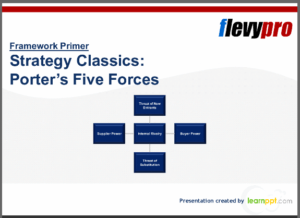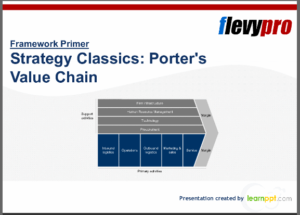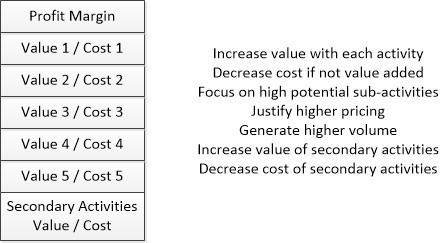The value chain provides a holistic way to look at a business’s configuration in terms of where and how it adds value, and at what cost and profitability.
Project management fits well into the value chain structure related to the portfolio management process as well as project execution. The value chain framework originated from a manufacturing mindset, but as the article shows is just as applicable to digital businesses. Regardless of type of business, a project’s purpose is tied very closely to how it goes about creating value chain advantage.
This post provides an overview of the original concepts from Michael Porter, a fresh approach more connected with the digital world, and implications of the value chain to the management of projects.
Primary Activities in an Organization’s Value Chain
Porter’s original approach reflected the more ‘manufacturing’ orientation of industry at the time. He outlined five (5) primary activities that businesses undertake to add value.
Here’s some detail on each.
- Inbound Logistics – This refers to the supply side of the business – anything that includes or supports inputs to the company’s processes. Some sub-activities under Inbound Logistics include identifying, ordering, receiving, and storing raw materials.
- Operations – This refers to the set of processes that convert the input materials and services into finished goods and services. Some sub-activities under Operations include blending, combining, converting, packaging, and labeling.
- Outbound Logistics – This includes all activities to distribute or deliver the final products and services to the end consumer. Some sub-activities under Outbound Logistics include storing, shipping, and delivery of products and services.
- Marketing & Sales – These are all the activities involved with communicating the value of the products and services to target customers. Some sub-activities under Marketing & Sales include advertising, devising promotions, developing appropriate messaging, identifying the appropriate channels, pre-sales consulting, sales meetings, pricing, and proposal development.
- Service – These activities include after sales support to enhance the customer experience. Some sub-activities under Service include customer support, maintenance services, warranty services, exchanges, and refunds.
The key is to identify those activities and sub-activities where the business can add the most value, and to invest most heavily in those areas.
—————————————-
Do you need some professional slides for a presentation on this or related strategic topics? I suggest the flevy Marketplace for Business Best Practices, and consider these particular Michael Porter documents:
| Strategy Classics: Porter’s Five Forces (28-slide ppt) – $25 | Strategy Classics: Porter’s Value Chain (23-slide ppt) – $25 |
—————————————-
Secondary Activities in an Organizational Value Chain
Porter also included four secondary, or supporting, activities related to the value chain.
Here’s a little more detail on these secondary activities.
- Procurement – The Procurement activity primarily supports the Inbound Logistics activity above – how the company acquires inputs to its processes.
- Human Resource Management – This activity is all about hiring, developing, and retaining employees. Human Resource Management affects all the primary value chain activities.
- Infrastructure – This activity includes critical support functions necessary for business operations, such as accounting, legal, and administrative activities. These affect all five of the primary activities above, and if they are performed poorly can severely handicap or even cause the demise of the business.
- Technological Development – The developments in this activity directly refer to improving processes and this most directly affects the Operations activity. However, there are business processes that Technological Development may touch in all the other areas too. This area particularly effects the ‘core’ processes that are strategic strengths of the organization.
The secondary activities, like the primary activities, can each be disaggregated into sub-activities. Improvements to these activities or sub-activities can reduce overall cost and affect the overall value chain.
—————————————-
The following are my three favorite Michael Porter books (paid links, also pictured below):
- “Competitive Strategy: Techniques for Analyzing Industries and Competitors“, by Michael Porter
- “Understanding Michael Porter: The Essential Guide to Competition and Strategy“, by Joan Magretta
- “Competitive Advantage: Creating and Sustaining Superior Performance“, by Michael E. Porter
And of course there are more excellent Michael Porter books.
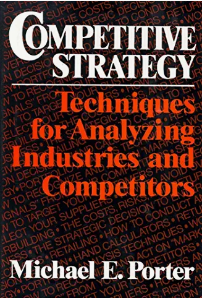 |
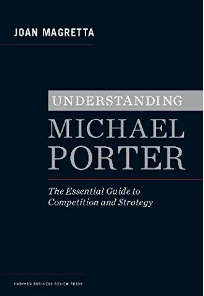 |
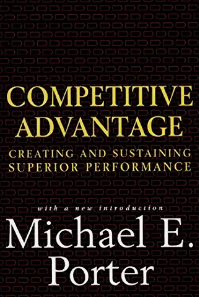 |
—————————————-
A Fresh Approach to the Value Chain
With all of these primary and secondary activities, the goal for the business is to differentiate itself from other competitors, add value for customers, and increase profitability. However, businesses today are not necessarily organized according to a largely manufacturing oriented template.
The idea of making the value chain activities generic seems applicable to situations where a different structure of the value chain applies. For example, network oriented businesses create value by providing an infrastructure that allows members to add value to products and services. The idea of inputs, outputs, and deliveries often does not work for this type of business.
Here is the generic representation. There may be five (5) – or more or fewer – value chain activities.
As with Porter’s foundational value chain model, value is created for each activity, and cost also is borne for each activity. Value chains can be reshaped on many dimensions with the goal of optimizing.
The chart below shows how the combination of values and costs associated with each activity result in a revenue and cost configuration with a resulting profit. Secondary Activities can also add value, and the cost largely falls into the overhead category.
The right of the chart lists some of the many things that can be done to change the revenue and cost configuration by making changes to activities in the value chain. One approach is to increase value in excess of the cost – for each activity. Another is to decrease the cost of activities that are not producing sufficient value.
It is a strategic, analytical decision to focus on the high potential sub-activities involved. That is a process much like project portfolio management. Other strategic drivers come into play, such as following the idea of creating more value to justify higher prices, or following a low cost strategy and going for higher volume.
Project Management and the Value Chain
—————————————-
I recommend these PM templates (paid link):
—————————————-
Project management supports the value chain and can even be part of the value chain.
Projects are created in order to enhance the organization’s value chain – to enable it to increase value at a cost less than that increased value. Projects that are aimed at improving a process, reconfiguring the business, replacing a support system, scaling production, or eliminating a cost that is not producing commensurate value all support the value chain.
The process of identifying projects, assembling the possible portfolio, and selecting the best projects is tied closely to a clear understanding of the value chain. The company’s approach to the value chain – what areas it seeks to emphasize to gain competitive advantage – will help determine which projects make up the final portfolio. Project managers will need to understand the value chain activities that the project supports and devise metrics accordingly that measure accurately if the objective is being achieved.
Every effort to improve an element of a primary activity, improve an element of a secondary activity, or improve how the various activities in the value chain are integrated together is a project. The results the business gets from executing these projects – the benefits of strengthening its value chain – is of course dependent on how well the project is executed.
In many businesses, projects are also part of the delivery process. Many product/service combinations include projects as a component. For example, delivery of a software application often includes implementation services, which entail projects. In those cases, excellence in project management, therefore, becomes part of the value chain activities and is part of the value proposition to customers.
Creating Value Chain Advantage in the Digital Age
This post reviewed the original more manufacturing oriented value chain framework and redefined it for digital application. Instead of adding value at each part of the manufacturing value chain – generically Inbound Logistics, Operations, Outbound Logistics, Marketing and Sales, and Service – it creates a more ‘open’ framework based upon ‘activities’.
Activities in a digital value chain can be anything that adds value, and since it uses a componentized business model, activities can be added and removed as they gain or lose value.
Project and program managers are often implementing these activities that are targeted to add value in the digital value chain. It is most important to understand the nature of the value being added, to find ways of measuring the value added as early as possible, and to have perspective of how any activity added to the value chain interacts as part of the whole value chain.
—————————————-
Do you need some professional slides for a presentation on this or related strategic topics? I suggest the flevy Marketplace for Business Best Practices, and consider these particular Michael Porter documents:
| Strategy Classics: Porter’s Five Forces (28-slide ppt) – $25 | Strategy Classics: Porter’s Value Chain (23-slide ppt) – $25 |
—————————————-

